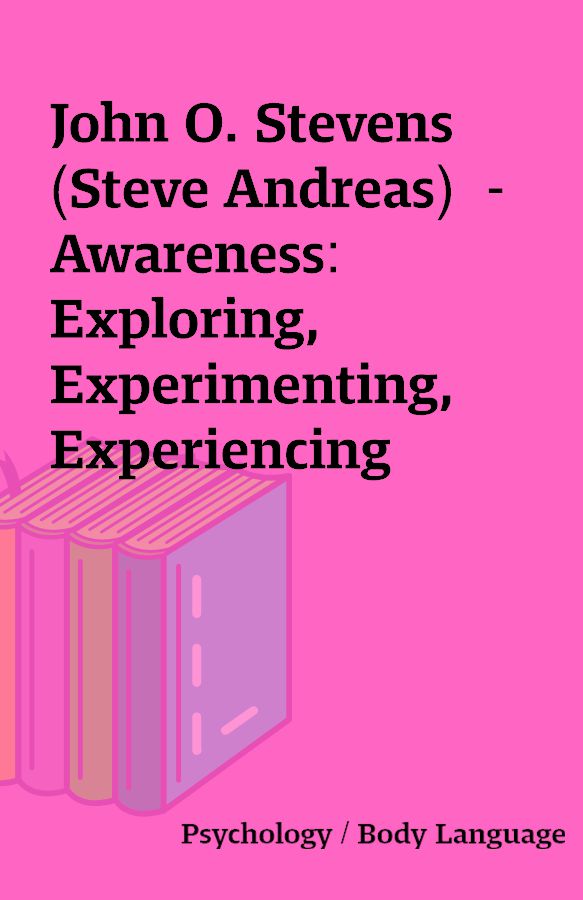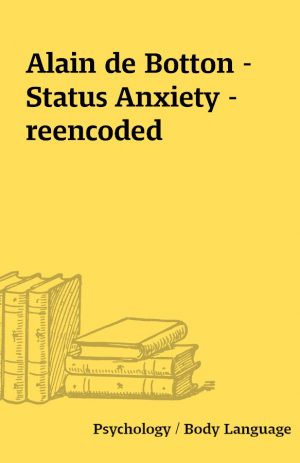John O. Stevens (Steve Andreas) – Awareness: Exploring, Experimenting, Experiencing
Awareness
[BookRip – 2 Docs, 2 PDF, 1 Mobi]
Description
Before he changed his name to Steve Andreas, John Stevens wrote this book about Gestalt Therapy games, which is probably the best set of experiments I have played with for cultivating awareness. Contains hundreds of games for cultivating awareness of sensation, your body, your dreams, your relationships, and the world around you.Awarness was first published in 1971 in the U.S.A., and quickly became a classic practical gestalt work with a reputation second only to the works of Fritz Perls, Carl Rogers and Virginia Satir. Awareness was born out of the author’s Gestalt Therapy work with groups of adults, and the application of these methods to his college teaching of psychology. It is about awareness, and how to explore, expand and deepen your awareness. Most of the book consists of experiments that provide opportunities for you to discover more about yourself, either working alone or with other people in pairs or groups. The methods outlined in this classic work will appeal to all those interested in awarness and personal growth, as well as counsellors, social workers, teachers, communicators, psychology students and Gestalt Therapists.You can find a lot more NLP stuff that Steve and Connie Andreas are doing here, but for whatever reason he decided to let go of the Gestalt stuff:http://steveandreas.com/Here is what he wrote about Gestalt Therapy 40 years on:https://realpeoplepress.com/blog/gestalt-therapy-40-years-onAfter getting an MA in psychology from Brandeis University in the early 1960s—a sort of consolation prize when I dropped out of a PhD program—and then teaching psychology for several years in a community college, I discovered Fritz Perls and Gestalt Therapy. The excitement of seeing change happen right before my eyes was a heady contrast to the other therapies that took months—or sometime years—to get anwhere. I became a “true believer,” and devoted all my spare time to learning how to do it, over a period of ten years, 1967-1977, when my name was John O. Stevens. (I took my wife’s last name when we married in 1981.) In 1969 I edited and published Perls’ Gestalt Therapy Verbatim and his autobiography In and Out the Garbage Pail, and the next year I wrote and published Awareness: exploring, experimenting, experiencing, a book that applied Gestalt principles in exercises that I was using in my college teaching.During this time I was invited by an Air Force psychiatrist to come up to his base and make a presentation to his staff. Walking to my car after the talk, Bill told me about his dissatisfactions with life in the military. He talked about the salary and all the benefits that kept him there, and all the rules and restrictions that rankled him. At one point he said, “I pay a terrible price for all that security.” I said, “Well, I guess we all have our price,” meaning that we all make difficult choices and compromises in a less-than-perfect world, and that benefits never come to us without some kind of price.Later I learned that my simple normalizing comment gave Bill permission to carefully examine the price he was paying, and he decided that he didn’t want to pay it any more. Since he had just signed up for a 3-year hitch, he couldn’t just quit. So he faked a psychotic depression, palmed and flushed the drugs they gave him, and was discharged soon after, free to find a new life with a different price. I wasn’t trying to “do therapy” with Bill, but my short comment, which couldn’t have taken longer than six seconds, had a literal life-changing effect, and ought to qualify for “briefest therapy.”At that time, “brief therapy” typically meant 10-20 sessions, and psychoanalysis took years, often with little to show for it. Although I was used to fairly rapid changes in Gestalt sessions, this was one of my first clues that—at least sometimes—personal change could be even faster and gentler. Perhaps if I knew more about the internal structure of someone’s experience, I could be more systematic about helping them change quickly. I don’t know anyone who thinks that a complex motor skill like playing a violin, basketball, or brain surgery can be learned quickly, but changes in attitude, orientation, and belief can often occur in seconds.Looking backward, Gestalt Therapy had some significant flaws, one of which was the “one size fits all” assumption that a single process will work for all kinds of different problems, an idea that is still quite pervasive in the field of therapy. In medicine, there are more than 13,000 distinctly different diseases, syndromes, and types of injury, most of which have a very specific intervention protocol. Contrast that with the current state of psychotherapy, in which there are over a thousand different named therapies (and how many unamed?) and nearly all of them assume that their one process will work with any and all difficulties.Gestalt assumed that stepping into every experience and fully experiencing it kinesthetically and emotionally was the key to resolution and change. This was particularly useful with grief, in which the feeling of loss results from seeing an image of the dead person at a great distance, or being separated from them in some other way. Stepping into a memory of love and connection with that person results in a full-body sense of presence, replacing the feeling of loss, and eliminating the grief.Stepping into a part of the person that is alienated, represented as “other” was also very useful for becoming more fully aware of the “shadow self,” sometimes called the “dark side” of the person, as a first step toward integration.However, fully experiencing all the feelings of a terrifying memory is of no use to someone who has a phobia or a PTSD flashback, because that is what they are already doing. If someone is making poor decisions, it will seldom be useful to step into the bad decision, but it can be very useful to view a series of decisions objectively to discover how the process itself is flawed, in order to improve it.To summarize, stepping into a memory is sometimes useful, while at other times, stepping out of it to become more objective is much more useful. Both are skills that everyone has, but most people don’t realize that they have them, or that they have a choice about which will be useful in a given context. Often alternating between the two will be most useful, reaping the advantages of each in turn.Gestalt was a part of the zeitgeist of the 1960’s that advocated paying attention in the here and now, which has been part of a number of very old spiritual traditions, and has been reincarnated recently in a secular form as “mindfulness.” In the context of Gestalt Therapy, paying attention in the present moment was a very useful advance over endlessly talking about the past, which was the most common approach at the time—and which still occupies a large part of most typical therapeutic sessions today. In a Gestalt session, talking about a problem was only a point of departure for acting it out behaviorally, doing something rather than reciting a well-rehearsed lifeless verbal “tape-loop” description.Whether role-playing and becoming some part of a dream, or talking to a parent or some other person in an “empty chair” dialogue, the nonverbal behavior in the present moment revealed key aspects of the interaction. Although this method was borrowed from Moreno’s psychodrama, a crucial difference was that the client’s enactment emerged entirely from their own inner world of experience, not inevitably distorted by someone else’s attempt to portray it.As the client shifted between being themselves and the “other,” shifts in their nonverbal behavior revealed vital aspects of their inner conflict. A man might verbally be expressing positive thoughts, but his hand might be clenched in a tight fist. The fist (which he often wasn’t aware of) often indicated anger, or open hands palm up suggested pleading. When Fritz would say, “Give your fist words,” or “What are your hands saying?” these nonverbal expressions added to the richness of the dialogue, and could participate fully in its clarification and eventual resolution.I can still hear Fritz saying, “Nyah, nyah, nyah” pointing out to a woman with a whining voice that she was implicitly asking someone else to do the work of lifting her out of her “poor me” victim role, provoking her to take charge of her life. And I can also hear him gently saying to someone else, “I hear your voice drenched with tears,” revealing a need to acknowledge and resolve a loss that colored her world a dull and lifeless gray.Someone, or something, in the real world might be very difficult to deal with, but in the context of a two-chair dialogue it became inescapably clear that the real conflict was between two (or more) parts within the client. When someone is yelling at a parent in the empty chair, but the parent is nowhere near—or may be dead and gone long-ago —it is obvious that they are actually yelling at their internal image of the parent, something that Virginia Satir was also very clear about.As the client successively acted out each side of the conflict kinesthetically, they identified with each, implicitly agreeing that each was a part of their own behavior, even if it was labeled “father” or “mother” or someone else. Each time they switched between parts, the transition from one to the other overlapped, and this tended to blend and integrate the two sides of the conflict. When integration was successful, that made it possible for the client to own and use all their personal behaviors and skills to deal with the external conflict in the real world.Like any other process, the usefulness of awareness in the present moment in the limited context of therapy can easily be overgeneralized to become a universal panacea. If someone noticed that we need to breathe in air, and then declared that we should always breathe in, their error would be apparent to most—especially if they tried to actually do that.However, the same fallacy is true of the doctrine of being aware of the here and now in contrast to the “there and then” of the past or future. While it can be very useful to be able to redirect attention from past disasters and future anxieties to the present moment, particularly for people who tend to overplan, the reverse can also useful. Many people already spend most of their life in the present moment, untroubled by past mistakes or future consequences. Those who overeat, abuse drugs, or engage in risky behavior of all kinds could benefit greatly from expanding their scope of time in order to pay more attention to the past and future.Images of the past and future can be very sustaining, and even life-saving, especially when the present is horrible. Viktor Frankl survived the Nazi death camps by vividly remembering being with his wife, and planning the talks and writing he expected to do after the war was over. Happy memories and exciting future goals are part of the experience of being human. Without the past and future, our lives would be as restricted as a chimpanzee’s.If you think that being in the here and now all the time would be wonderful, spend a few minutes watching a YouTube video of Clive Wearing, who has a memory lasting only 7-30 seconds, and you will soon be released from that particular delusion. Jill Bolte Taylor provides another very interesting report of being in the here and now in her TED talk, “My stroke of insight.” She loved being in the present moment—what she called “la la land”—but it made her incapable of making a simple phone call to save her from the stroke that intermittently shut down her ability to understand and use language.One particularly admirable aspect of Gestalt Therapy was Perls’ willingness to record his work on film—when it was far more expensive and difficult than it is today. Now anyone with a smart phone can record events with the tap of a finger—and without the bright lighting that filming used to require. Virginia Satir, Albert Ellis, Carl Rogers, and a few others also made film and video recordings, so that others could see and hear exactly what they did in therapy sessions. That kind of openness is still very rare in the field; most therapists prefer “private practice.” I have often tried to locate videos of prominent therapists, so that I could see exactly what they did in sessions. But usually all I can find are lectures about their work, and their theories, not the work itself. Some prominent therapists have made “therapy” films based on actual cases, but using trained actors—producing only a distorted caricature of what actually happens in therapy.The main reason often given for not videotaping real client sessions is client confidentiality. However, I think that “client confidentiality” is more often protection for the therapist, rather than the client—a way for therapists to avoid revealing what they do—and how long it takes for them to make any progress at all. I have found that most clients are quite willing to be videotaped if you tell them that no public use will be made of the video without their written permission. Even when they have this absolute veto power, very few have exercised it.Another valuable aspect of Gestalt was that it usually occurred in groups, so all group members could observe the struggles of the person in the “hot seat” who was actively working with the therapist. The benefits of observing others ranged from simply becoming familiar with the process, and the typical benefits of the process, to complete “piggybacking”—stepping into the shoes of the protagonist, and getting personal resolution for themselves.When a client had fully identified with a rejected and alienated part, s/he was often asked to go around to the other people in the group and act out that part in relation to each person. For instance, if a “dark side” part was arrogant or insulting, the client would be told to be arrogant and insulting to each person in the room in turn. Usually their insults would vary in interesting ways as they responded to the personality or behavior of each person, targeting their individual weakness or sensitivity. The insult to one person might be to their appearance, another’s intelligence would be demeaned, while a third’s social status would be scorned. This combined expressing and owning the problematic behavior with making authentic contact with others in the group. This provided a behavioral richness and texture far beyond the word “arrogance,” making it very clear exactly how pervasively someone’s “dark side” was expressed in their interactions with others.Although these processes were quite useful, they required publicly acting out aspects of their personality that were often embarrassing to clients. Some were understandably reluctant to do this, a significant obstacle that prevented some from benefitting fully, or at all.Although Gestalt was quite good at revealing the dynamics of internal conflicts, and eliciting alienated behaviors, it was not nearly as effective in resolving them. The client kept switching back and forh between the two parts of the dialogue until integration occurred. Sometimes this took a long time, and it often involved a lot of broken furniture as they acted out their anger and fantasies of revenge on the empty chair.This was primarily because Gestalt didn’t include the presupposition of positive intent behind every behavior. Assuming positive intent makes it much easier for us to accept an alienated part, and be willing to identify with it and learn from it. Gestalt took a small step in this direction by assuming that every alienated part had a valuable power. No matter how troublesome or destructive a behavior was, it was a resource that could be integrated and used in more positive ways if it was acknowledged as part of the self. The only real choice was between the present state in which the alienated part would express its power in whatever way it wanted, or identifying with it, taking it into the self, and gaining some degree of choice about how the power was expressed.However, acknowledging the power in a troublesome aspect of behavior is not nearly as convincing and liberating as realizing that an alienated part is already performing a positive function that can be acknowledged and celebrated, building a positive alliance with the part. For instance, a parent’s withering criticism might have the positive intent of motivating a child to succeed, as well as the positive intent of expressing the parent’s feeling of helpless frustration.Since the child also wants to succeed, the parent and child are now in agreement about the intent, so they can now explore together how to alter the problematic behavior to make it even more effective in achieving the positive intent. Once this alliance is established, it is relatively easy to work together with the part, instead of battling with it.There are actually three fundamentally different kinds of positve intent, and they can be illustrated in a familiar scenario in which a parent or other important person criticizes a child, and the child understands this behavior as meaning something about the child. Often a criticism is a clumsy overgeneralization like, “You’re stupid,” or it’s loaded with unuseful presuppositions like, “Why won’t you ever grow up?”The parent’s positive intent could be entirely for the parent—to express frustration, to be “right,” to get the child to behave in a way that makes the parent feel better or look better to others—or some other benefit to the parent. When this is the only positive intent, it changes the emotional significance of the criticism. It becomes obvious that the criticism results from the parent’s limitations, and really has little or nothing to do with the child, so the child no longer needs to be troubled by it.The parent’s positive intent could be entirely for the child’s benefit—in order to shape their behavior in ways that the parent believes will help the child have a satisfying and productive life. When this is the case, the task is to modify the criticism so that it provides positive guidance and useful feedback to the client. For instance, criticizing a failure, and the unpleasant feelings that result from that, can be replaced with setting an attractive positive goal, and specifying and learning the detailed behaviors that can achieve it.The parent’s criticism could have the intent of making life better for a third party—someone else who would benefit from a change in the child’s behavior. The positive intent in, “You’re too loud” might be for someone else who is resting. In this case, the client needs to carefully acknowledge and consider both their own needs and those of the third party. Usually some rebalancing of the client’s needs with the needs of others will resolve the inevitable differences that arise between people. Being “too loud” is transformed from a universal statement about the child to a choice in certain situations in which someone else is negtively affected by loudness.Of course these three kinds of positive intent are not mutually exclusive; a single critical comment could include two, or all three, kinds of positive intent simultaneously.When this is the case, it is useful to sort out the different aspects of intent, and deal with each appropriately—ignore it, modify it, or rebalance it.Most current “parts work” or “internal family systems” work is similar to Gestalt. Either they don’t use positive intent, or they use it imprecisely, limiting its usefulness. Many other approaches either oppose a part, or try to eliminate the part altogether, which is even worse.With the understanding that all aspects of a person (feelings, behaviors, thoughts) have positive intent, conflicts can be resolved much faster. Rather than have a client act out the two sides of a conflict overtly by switching chairs, I now often ask clients to close their eyes and have an internal dialogue with someone, or some part of themselves, with only occasional guidance from me. Since the client only needs to reveal the general character of what occurs in the dialogue, they don’t have to report, or act out, aspects of themselves that could prove embarassing, making it much easier to achieve mutual understanding between conflicting parts, and eventual integration.Although I have learned many, many specific distinctions, interventions and ideas about therapy since those long-ago days, there are certain core principles from Gestalt that continue to underlie and guide everything I do with a client:Every aspect of our experience is a part of ourselves. Any attempt to eliminate or destroy any part of our experience only perpetuates and escalates conflict.Since every experience we have is a part of us, attempting to eliminate any aspect of it is doomed to failure—and if it were to be successful, that would make us less whole, less capable, and less human.Every aspect of our experience needs to be acknowledged, understood, and utilized in the contexts in which it is most useful, integrating it smoothly into the fabric of our lives.After ten years of being deeply involved in Gestalt, I discovered neuro-linguistic programming (NLP). Again there was the heady excitement of learning a radically new way of helping people change, with all its challenges, frustrattions, and discoveries. NLP offered very specific ways to elicit and verify a client’s internal experience, as well as a multitude of ways to alter that experience in order to resolve problems. The field continues to evolve, often far beyond its stumbling iconoclastic beginnings in the early 1970s, when Richard Bandler and John Grinder first developed it. What’s next? An interviewer asked a famous songwriter, “Of all the songs that you have written, what is your favorite?” The songwriter replied, “The next one.”
You must be logged in to post a review.






Reviews
There are no reviews yet.